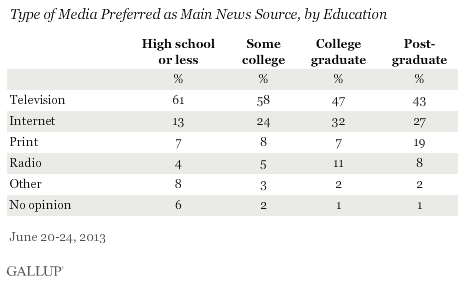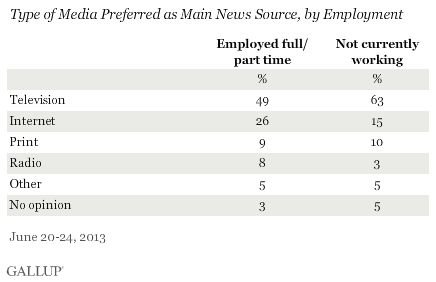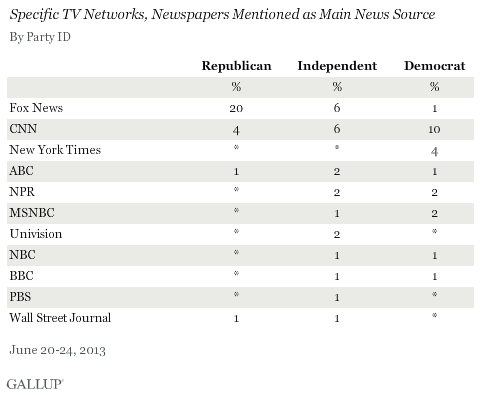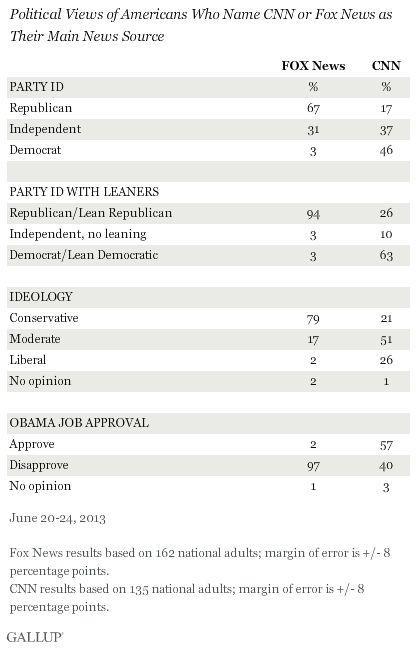PRINCETON, NJ -- Television is the main place Americans say they turn to for news about current events (55%), leading the Internet, at 21%. Nine percent say newspapers or other print publications are their main news source, followed by radio, at 6%..

These results are based on a Gallup poll of 2,048 national adults conducted June 20-24, in which Americans were asked to say, unaided, what they consider to be their main source of news about U.S. and global events.
More than half the references to television are general, with 26% simply saying they watch television or TV news, 4% saying they watch local TV news, and 2% saying they watch the "evening news." The two leading 24-hour cable news channels -- Fox News and CNN -- are named by 8% and 7%, respectively. However, no other specific channel -- including MSNBC, PBS, BBC, and all of the U.S. broadcast networks that once dominated the news landscape -- is mentioned by more than 1% of Americans.
The vast majority of those citing the Internet -- 18% of all Americans -- either mention the Internet generally or say they get their news "online." Two percent identify Facebook, Twitter, or social media as their source, while 1% mention a specific online news site.
The New York Times and Wall Street Journal are each named by 1% of Americans -- the only specific print publications to earn as much as 1% in the poll.
As a measure of U.S. adults' perception of their primary news source, the question provides insights into the importance of various types of media and news outlets as information sources to the public. It is not meant to indicate the total reach each news outlet has in the population, nor do the results necessarily correspond with television ratings data.
TV Is Primary News Source for All Age Groups
If the current media preferences of young adults are any indicator of the future, the data offer good news for TV, but bad news for print media. Half of adults aged 18 to 29 and half aged 30 to 49 identify television as their main source of news. This is nearly double the rate for the Internet even among these more tech-savvy populations. However, it does differ from older generations who put relatively more emphasis on TV and less on the Internet.
At the same time, heavy reliance on print is exclusive to seniors, among whom 18% cite newspapers or other print publications as their main source of news. By contrast, 6% to 8% of younger age groups rely on print.
Few adults of any age say their main source of news is radio. While many Americans certainly tune in to radio for entertainment as well as talk radio, it is clearly not the place most turn for hard news about current events.

In additional to older Americans, highly educated Americans -- college postgraduates -- put the most emphasis on newspapers or other print publications, with 19% naming it as their main source of news. However, this drops to 7% among college graduates, 8% among those with only some college education, and 7% among those with no college experience.

Employment Also a Key Determinant of News Choices
Working Americans -- those employed, either full or part time -- are much more likely than those not currently working to identify the Internet as their main source of news, 26% vs. 15%. Those not working prefer television at a correspondingly higher rate; nevertheless, television is the top choice among both groups.
Additionally, employed adults are more likely to cite radio as their primary news source, likely reflecting the listening habits of some commuters.

Republicans Lean Most Toward TV; Democrats Are Heaviest Print Users
Gallup also finds slight partisan differences in where Americans choose to get their news, although television dominates among all three major groups.
On a relative basis, Republicans are more likely than independents or Democrats to say their main source of news is television. At the same time, independents rely the most of the three groups on the Internet, while Democrats put the most emphasis on print.

Fox News is a clear driver of Republicans' higher tendency to turn to television for their news, with 20% versus 6% of independents and 1% of Democrats, naming it as their main news source. No other television, print, or online news source generates as much loyalty from either Democrats or independents. The closest is CNN, named by 10% of Democrats, 6% of independents, and 4% of Republicans.

Fox and CNN Viewers Differ Demographically, Politically
Underscoring the different partisan preferences of those who rely on Fox News vs. CNN for their news, the demographic and political profile of Americans who name each as their top news source are highly distinct. For example, nearly two-thirds of Fox News-oriented news consumers are 50 and older, compared with barely a third of CNN-oriented news consumers: 66% vs. 35%. Relatedly, 69% of the Fox News group is married, versus 37% of the CNN group.
Additionally, core CNN viewers are more likely than core Fox News viewers to be male, while core Fox News viewers are much more likely than core CNN viewers to be white, Protestant, attend church weekly, and to earn $75,000 or more per year.
The demographic profile of Americans who name Fox News as their main news source is similar to the profile of Republicans, and for good reason. Two-thirds of core Fox News viewers identify themselves as Republican, and 94% either identify as or lean Republican. By contrast, 46% of core CNN viewers identify as Democrat, and 63% identify as or lean Democratic.
Relatedly, 79% of the Fox News group describes their political views as conservative, 17% as moderate, and 2% as liberal. Among the CNN group, 21% are conservative, 51% are moderate, and 26% are liberal. Just 2% of the Fox News group, compared with 57% of the CNN group, approves of the job President Barack Obama is doing.

Bottom Line
Americans have an abundance of sources at their disposal for acquiring news, and accordingly, Gallup received various answers when asking respondents what they consider to be their main source. Still, the television medium leads all others, and by a wide margin over the Internet, while print and radio lag well behind. This does not mean Americans get no news from print, radio, or to a lesser degree the Internet; just that relatively few see these as their main source.
The poll also documents the balkanization of news, primarily based on politics, but also to a lesser degree by age and education. Republicans have a strong orientation toward Fox News and Democrats lean somewhat more toward CNN and various other news outlets. Younger Americans seek out Internet news more than other age groups, and highly educated Americans tend more than other groups to get their news the old-fashioned way, reading a newspaper or magazine.
Scientific polling has been around for less than a century, but had it existed from the nation's start, it surely would have documented dramatic changes in how Americans receive information about national and global events, shifting from word of mouth, to pamphlets and newspapers, to magazines. The advent of radio ushered in the modern era of people experiencing the news together, herding families into their living rooms. This was eventually replaced by the television set. Today, the Internet is ascending, but it remains to be seen if it will displace television as much as it will newspapers. Right now, the Internet is strongest among younger, working Americans, but presumably, this will change as the population ages. At the same time, newspapers strongest market, seniors, will disappear, leaving the future of that medium in serious doubt.
This is the first time Gallup has measured Americans' media habits with this particular open-ended question, but in 1957, Gallup approached the same issue by asking: If you had to give up one of these -- radio, television, the newspaper, or magazines -- which one would be the hardest for you to give up? Americans at that time were most likely to name television, at 45%, followed by newspapers (27%), radio (21%), and magazines (4%).
Survey Methods
Results for this Gallup poll are based on telephone interviews conducted June 20-24, 2013, with a random sample of 2,048 adults, aged 18 and older, living in all 50 U.S. states and the District of Columbia.
For results based on the total sample of national adults, one can say with 95% confidence that the margin of sampling error is ±3 percentage points.
Interviews are conducted with respondents on landline telephones and cellular phones, with interviews conducted in Spanish for respondents who are primarily Spanish-speaking. Each sample of national adults includes a minimum quota of 50% cellphone respondents and 50% landline respondents, with additional minimum quotas by region. Landline telephone numbers are chosen at random among listed telephone numbers. Cellphone numbers are selected using random digit dial methods. Landline respondents are chosen at random within each household on the basis of which member had the most recent birthday.
Samples are weighted to correct for unequal selection probability, nonresponse, and double coverage of landline and cell users in the two sampling frames. They are also weighted to match the national demographics of gender, age, race, Hispanic ethnicity, education, region, population density, and phone status (cellphone only/landline only/both, cellphone mostly, and having an unlisted landline number). Demographic weighting targets are based on the March 2012 Current Population Survey figures for the aged 18 and older U.S. population. Phone status targets are based on the July-December 2011 National Health Interview Survey. Population density targets are based on the 2010 census. All reported margins of sampling error include the computed design effects for weighting.
In addition to sampling error, question wording and practical difficulties in conducting surveys can introduce error or bias into the findings of public opinion polls.
View methodology, full question results, and trend data.
For more details on Gallup's polling methodology, visit www.gallup.com.
